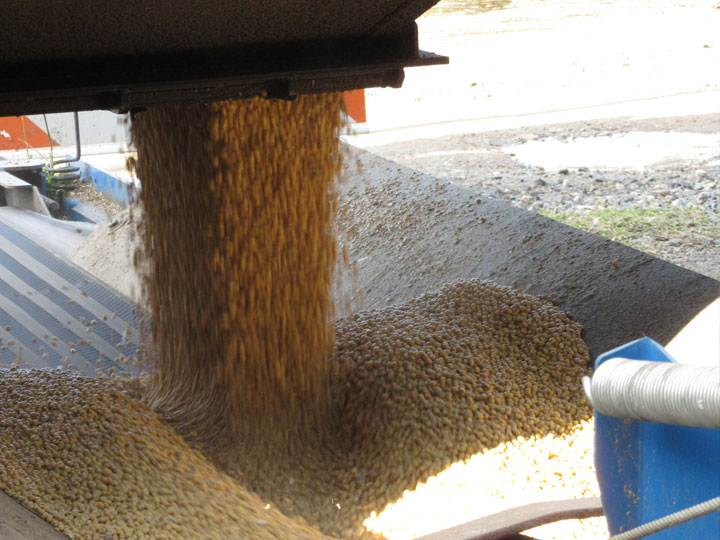






Members of all three districts within the Northwest Soil and Crop Improvement Association (NWOSCIA) had a great opportunity to take part in a tour of James Richardson Ltd.’s Thunder Bay operations, along with lunch and a presentation by Canada Malting, on Friday, November 3, 2017.
For over 150 years, Richardson has become and remains Canada’s oldest and largest privately-owned company, and proudly stands its ground as Canada’s largest agri-businesses. Responsible for the marketing and management of grain and oilseed, Richardson has given Canada a reputable spot on the map within an international market, supporting communities across our country through their refined business practices.
NWOSCIA Regional Director Andrew Brekveld did a great job of organizing the event together with Jim Dogget and Ryan Fay, Operation Managers at Richardson. This first time event held through NWOSCIA turned out to be one of its best attended events ever, boasting an attendance of about 70 members, both young and old. Attendees were made up of mainly members of the Thunder Bay Soil and Crop Improvement Association (TBSCIA) but also included four members from the Rainy River Soil and Crop Improvement Association (RRSCIA) and one member from Kenora District Soil and Crop Improvement Association (KDSCIA) who made the trek out to partake as well. Funding to cover travel costs for these individuals was made possible through the Ontario Soil and Crop Improvement Association (OSCIA) Tier One Grant, which is funding available to support communication events for local/regional Soil and Crop Associations such as educational activities, field days, guest speakers, demonstrations of new equipment or management techniques, and the like.
The tour started off on a cold, windy morning, where attendees were asked to meet at the James Richardson Ltd. Elevator, located along the north shores of Lake Superior just outside of Thunder Bay. Participants were, however, able to keep toasty warm while the staff at Richardson’s prepared individuals on how the tours would be run. Split into three groups, participants were outfitted with proper safety gear including safety glasses, hard hats and bright coloured safety vests. Prior to the tour, participants had also been instructed to wear proper footwear.
A grain truck had recently rolled into the yard, so staff guided the group towards the location where the truck was unloading. Grain poured through a shoot from the belly of the grain holding area, which then spilled onto a conveyor belt, and travelled up into the receiving location.
From there the group split, one third of which began the tour while the other two thirds were able to keep warm within a large storage area.
Richardson’s staff started off the tour along the water’s edge, where the ships are loaded. A very large area is used to accommodate these ships, which are loaded with large amounts of grain from as far as the Canadian prairies. These ships then carry grain and oilseed to various destinations across Lake Superior, many also sailing onwards to the St. Lawrence seaway and Atlantic Ocean waters. Unfortunately there were no ships presently being loaded.
Most grain is brought in from many miles away by rail. Train cars which travel hundreds of kilometres make the trek to one of two locations from where Richardson ships internationally via ship – Vancouver and Thunder Bay. Participants on the tour were able to view a collection of stationary train cars which had been unloaded very similarly to the grain truck. The underside of each train car included a shoot which was then hooked up to a specific handle to open and unload grain.
The final stop of the tour was “control central”, where facilities are kept under a close eye through computerized systems and their users. This was also the location of grain inspection, where various staff members thoroughly inspect each train car and truck load of grain which is shipped through Richardon. Various sampling and testing is done to ensure proper quality of grains which is then reflected in the end-users pricing. And, since Richardson ships to so many international locations such as China and Mexico, and various countries within Europe, South America and Asia, each load is inspected throughly to ensure the quality what the buyer expects is what they will receive.
Following the tour, a lunch at the Polish Hall followed which was generously sponsored by Richardson as well. Members were eager to warm up to a hot cup of coffee and delicious beef on a bun, which was served very shortly after arrival at the hall. After filling their bellies and carrying out some good farm-talk conversations, members were keen to partake in the next item on the agenda, a presentation on grain pricing through John Prodanuik of Richardson. Members of NWOSCIA learned that they are at a great advantage when it comes to selling their grain/oilseed due to the fact that they are able to avoid rail costs. Anything from canola, soybeans, wheat, barley and corn is able to be shipped through Richardson, which takes on the marketing of a total of 12 different crops. Other highlights in John’s presentation included where Canada sits on the grain market from an international standpoint; thought Canada only makes upwards of 2% of the world’s production, we currently sit at 8% of all global exports in this area. And Richardson has certainly contributed to this success.
A big thank you goes out to the staff at Richardson’s Thunder Bay location for the phenomenal tour as well as sponsorship of the lunch. Also thank you to the Polish Hall for the fabulous meal, and to Johnfor the educational presentation which Soil and Crop members were treated to. This event certainly proved to be a large success, and so lastly we thank the members of NWOSCIA who took on the initiative to allow for another great Soil and Crop event to be made possible!

